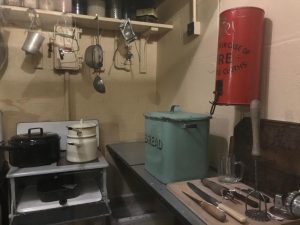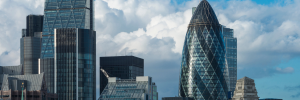Buckingham Palace is globally recognised as the heart of the British monarchy, transformed into a bastion of resilience and unity during this time of unprecedented conflict. It was within the palace’s scarred walls that crucial moments of wartime diplomacy unfolded, including a notable visit from the United States’ First Lady, Eleanor Roosevelt. Join us as we delve into the palace’s experiences during the war, uncover the significance of Mrs Roosevelt’s visit, and explore the palace’s role as a rallying symbol of steadfast courage and resilience in the face of adversity.
During World War II, London experienced a level of destruction and upheaval that changed the landscape of the city forever. From the East End to the West End, no district was spared the terror of the Blitz, a prolonged bombing campaign carried out by the German Luftwaffe between 1940 and 1941. Even the iconic Buckingham Palace, the primary residence of the monarchy, was not exempt from the onslaught. Buckingham Palace was the backdrop for key moments in wartime diplomacy, including the notable visit by First Lady Eleanor Roosevelt.
Buckingham Palace during the World War II
The Blitz began in September 1940 and for 57 consecutive nights, German aircraft bombarded London, targeting key infrastructure and strategic points to demoralize the British public and force a quick end to the war. However, the indomitable spirit of the British people ensured that the nation continued to function and resist amid the chaos.
At the onset of World War II, Buckingham Palace, like many other significant structures in Britain, was at high risk. The Palace, being a symbol of British monarchy and power, could potentially become a prime target for German bombings.
The Bombing of Buckingham Palace
On September 13, 1940, Buckingham Palace was hit by German bombs for the first time. This was not a deliberate target by the Luftwaffe, but rather a consequence of the broad, sweeping attacks carried out across London.
The bombing occurred during the late morning, with five bombs dropped on the palace. One of these bombs fell on the palace’s inner quadrangle while another exploded in the palace’s chapel, destroying it. Miraculously, King George VI and Queen Elizabeth were in residence at the time but were unharmed.
The King and Queen’s Reaction
Instead of dampening the spirit of the monarchy, the attack solidified King George VI and Queen Elizabeth’s determination to stay in London and share the risks and hardships faced by their subjects. Upon learning of the destruction to the chapel, Queen Elizabeth famously said, “I’m glad we’ve been bombed. Now I feel we can look the East End in the face.” This statement greatly boosted the morale of the British people, demonstrating the shared determination between the monarchy and its subjects.
King George VI also noted in his diary the “unforgettable” sight of the bombed palace and described it as a “symbol of the steadfastness of London.” Their decision to remain in the bombed city earned them deep respect from Londoners and people across the nation, creating an enduring symbol of British resilience.
The September attack was not the only one Buckingham Palace endured during the war. Throughout the war, the palace was bombed a total of nine times, causing various degrees of damage. But, the King and Queen’s decision to remain in the bombed city conveyed their strong commitment to their country, significantly boosting national morale.
The bombing of Buckingham Palace during WWII serves as a stark reminder of the turbulent times that London endured during the early 1940s. However, it also stands as a testament to the resilience of a nation. The steadfastness of King George VI and Queen Elizabeth, their refusal to leave their people behind, boosted national morale and symbolised the unity and indomitable spirit of the British people.
Even amidst the rubble and ruin, the Palace, like the British people, stood firm, a testament to resilience, courage, and an unwavering commitment to democracy and freedom. Today, the repaired and restored Buckingham Palace continues to serve as a symbol of the British monarchy’s continuity, endurance, and service to its people. It is a testament to a nation’s resilience in the face of hardship and the enduring power of unity and determination.
The Visit of Eleanor Roosevelt
Amidst this backdrop of wartime hardship, one of the more significant events at Buckingham Palace during World War II was the visit by Eleanor Roosevelt in October 1942. At that time, her husband, President Franklin D. Roosevelt, had already led the United States into the war following the bombing of Pearl Harbour in December 1941.
The First Lady embarked on a fact-finding mission on behalf of her husband to assess the mood, needs, and morale of the troops and civilians. Her itinerary was wide-ranging, covering military bases, factories, hospitals, schools, and air raid shelters. It was an exhaustive tour that brought her face-to-face with the harsh realities of the war.
The highlight of her trip was a visit to Buckingham Palace, where she was personally received by King George VI and Queen Elizabeth. Mrs Roosevelt spent three nights in the palace, during which she had an opportunity to view the war’s impact firsthand. She even saw the damage inflicted by the bombings, including the destroyed palace chapel.
In her “My Day” newspaper column, Mrs Roosevelt wrote, “There is one nice thing about a home that has been lived in for so long a time. Even though there are spots where bombs have done their worst, the general feeling is one of continuity.”
The Impact of the Visit
Eleanor Roosevelt’s visit to Buckingham Palace played a crucial role in solidifying the bond between the United States and the United Kingdom. It humanized the war for many Americans back home, helping to cement their support for the allied cause. Her reports and anecdotes brought home the realities of the conflict, eliciting widespread empathy and understanding.
Buckingham Palace as a Symbol of Resilience
Buckingham Palace’s story during World War II is one of resilience and courage. It survived the war’s tribulations, serving as a steadfast symbol of the British monarchy’s unwavering dedication to its people. Eleanor Roosevelt’s visit to the palace, and her firsthand account of the war’s impacts, helped to cement a key alliance and rallied support for the shared cause. This history underscores the palace’s role not just as a residence, but also as a critical site in world history.
Listen to London History Podcast Episode 114: Buckingham Palace




